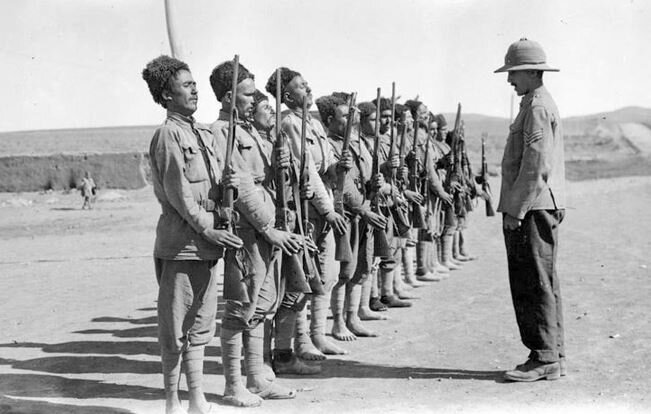Neutral Iran one of the biggest victims of WWI
How the country’s sovereignty, integrity, and dignity was trampled by foreign soldiers in WWI

TEHRAN – The 1917-1919 famine in Iran, which claimed the lives of 8 to 10 million people out of a population of 18 to 20 million, is sometimes called the Iranian Holocaust.
This catastrophic event, one of the worst calamities of World War I, was due to the British, Russian, and Ottoman invasions that had blatantly disregarded Iran’s declaration of neutrality. However, many argue that a stronger Iranian military and more robust government would have prevented or mitigated the invasion itself.
How did Iran’s disastrous situation begin?
Iran was already in turmoil before World War I, paving the way for foreign invasion. The Qajar dynasty had seen Iran grow weaker, losing territory to its powerful northern neighbor, Russia.
In Tehran, political turmoil raged as Ahmad Shah's father, Mohammad Ali Shah Qajar, attempted to overturn the Constitutionalists' achievements in establishing a fragile constitutional monarchy, aided by Russia.
The Constitutionalists had previously forced Mohammad Ali Shah's father, Fath Ali Shah, to accept an elected parliament, or Majlis. After numerous clashes between Mohammad Ali Shah and the Majlis, Mohammad Ali Shah dissolved parliament and imposed martial law. This sparked a nationwide revolt, forcing Mohammad Ali Shah's abdication in favor of his son, Ahmad Shah Qajar, who restored the constitution in 1909.
Even before World War I began, foreign powers partially occupied the country, undermining the central government. Widespread poverty and famine further destabilized the nation.
Invasion of Iran by Ottomans in 1906
The invasion of Iran by the Ottoman Empire occurred in 1906 during the Constitutional Revolution. The Ottomans had laid their control over some parts of the country in the northwest, collecting taxes from the people. It was the Russian troops who drove out the Ottoman troops before the First World War began in 1914.
1907 Anglo-Russian Convention
According to the 1907 Anglo-Russian Convention Britain and Russia settled their colonial disputes in Iran, Afghanistan, and Tibet. The pact delineated spheres of influence in Iran. They divided the country into spheres of influence: a Russian zone in the north, a British zone in the south, and a neutral buffer zone in the rest of the country, in which both the British and the Russians shared power.
1911 occupation of Iran by Russia
A rebellion in Tabriz in northwest Iran in June 1908 resulted in a siege situation there. Britain and Russia had agreed that a Russian force should be sent to occupy it. The Russians occupied Tabriz in April 1909. Negotiations for its withdrawal soon began but continued until 1911. The Iranian constitutionalists resisted fiercely against the Russian imperial army. About three days later, the defense of the city broke, the Russians shelled Tabriz with artillery and entered the city on 31 December 1911. The Russians executed the constitutional revolutionaries of Tabriz, their families, and many civilians of Tabriz as well. The Russian forces remained in the city until 1917.
Declaration of neutrality in World War I by Ahmad Shah
Upon the outbreak of World War I, the Iranian government, under the last Qajar king, Ahmad Shah, declared strict neutrality by royal decree on November 1, 1914.
Iran was in a terrible situation when the war started. The constitutional movement had faced the opposition of Mohammad Ali Shah prior to the war. Different political groups were fighting for superiority at both local and national levels.
At the war's outset, Iran faced dire circumstances. The pre-war constitutional movement had been opposed by Mohammad Ali Shah, and various political factions struggled for power at both local and national levels.
Ahmad Shah, was ill-equipped to rule as rival political leaders emerged. Nobody took him seriously. He further pushed the country into crisis. The central government’s control was in constant decline. It was being transformed into a khanate. It was not even able to collect taxes, and the treasury was broken and running out of cash.
Under these circumstances, World War I not only increased external pressure on Iran but also caused the long-standing fractures in Iranian politics to broaden and the central government to become more divided and fragmented than ever. None of the subsequent administrations that came to power in Iran lasted more than a few months.
Despite Iran's declared neutrality, the war reached its borders in December of 1914. Ottoman and Russian forces attacked or occupied the north, while Britain extended its influence in the south.
World War I's end offered Iran little relief; its concerns were ignored at the Congress of Versailles. A coup ended Qajar rule, with military commander Reza Khan becoming Shah after suppressing his rivals. Despite his claims of a strong military, Iran was again occupied by the British and Russians by the end of his reign, leading to his exile and replacement by his son, Mohammad Reza Pahlavi. The latter's alliance with the United States further destabilized Iran until the 1979 Islamic Revolution under Imam Khomeini.
Today, Iran wields significant regional and international influence. Under the Islamic Republic and its current leader, Ayatollah Seyyed Ali Khamenei, the country plays a major role in resolving various issues both within and outside the region.
Leave a Comment